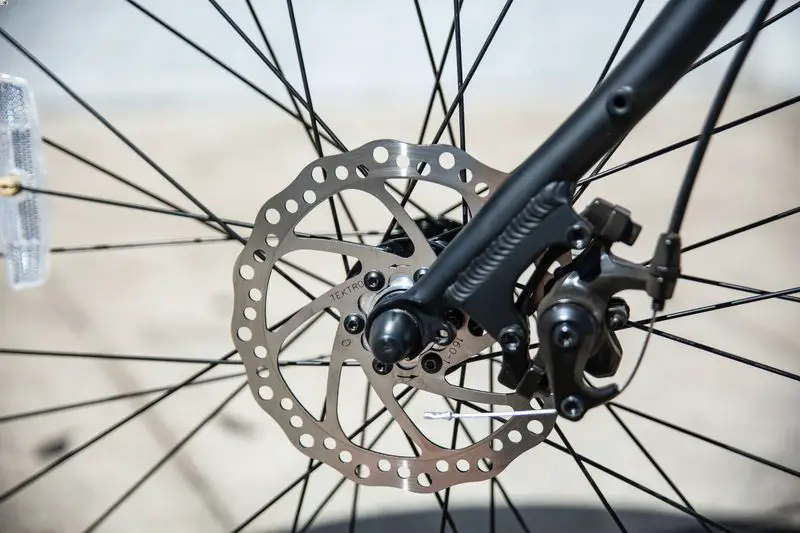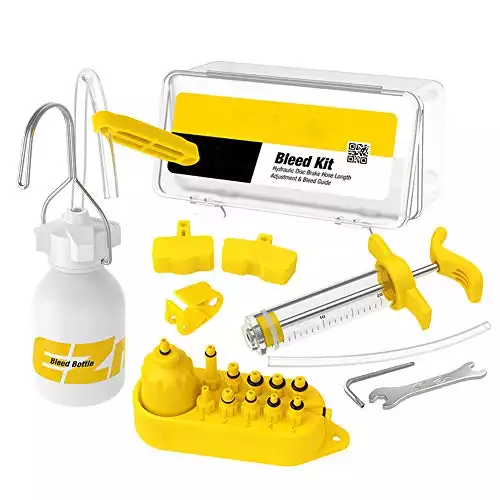Disc brakes can be found on almost every type of bike nowadays. In fact, they are available even on entry level bikes. They come in two variety: hydraulic and mechanical.
Mechanical disc brakes are cable actuated: the brake levers and the pads are connected with a cable in a similar fashion to most rim brakes. Hydraulic disc brakes have hydraulic fluid running in a fully sealed tube from the levers to the pistons. When pressure is applied on the brake levers it is hydraulically transferred to the brake pads.
While both types of brakes offer plenty of stopping power, hydraulic disc brakes require less maintenance and are easier to modulate; they can even be operated with a single finger. When servicing is needed, mechanical disc brakes are easier to repair and maintain, which is why they are the preferred brake type by some tourers.
Common characteristics of hydraulic and mechanical disc brakes
Both hydraulic and mechanical disc brakes share some characteristics in common. They apply stopping power to the disc rotor attached to the hub of the bike wheel.
Electric bikes built for everything and priced for everyone. Shop Rad Power Bikes, America's #1 electric bike brand. Get out. Go further. Ride Rad.
The disc is made of durable steel and ranges from 140 mm to 180 mm in diameter. The larger the diameter of the disc the more the stopping power.
160 mm is quite standard, and sometimes 140 mm discs can be found on rear wheels because less stopping force is needed for the rear wheel than on the front one. The difference in stopping power between a 140 mm disc rotor and a 160 mm one is 13%. Some downhill bikes where sudden braking is imperative, have 180 mm front rotors.
There are holes on the disc, which help dissipate water on the braking surface and provide excellent stopping power even in wet conditions. The holes also allow for more efficient heat dispersing.
A big advantage of both types of disc brakes is that they are not as close to the ground as the rim of the bicycle, and therefore they are less likely to pick up contaminants from the ground. This is a big advantage in wet conditions, where the first wheel rotation in the case of a rim brake serves to wipe the water off the rim, whereas disc brakes engage immediately.
Since the force is applied directly at the hub as opposed to the outer diameter of rim brakes, you can feel the stopping power of disc brakes sooner than rim brakes.


Disc brake rotors are made of steel and are very durable. They are of two variations: centerlock and 6-bolt. This goes for both hydraulic and mechanical disc brakes. The difference is in how it’s placed on the hub. Centerlock disc brakes are made by Shimano and need a special tool to be mounted on the wheel (a Shimano bottom bracket removal tool like this one on Amazon), while 6-bold disc brakes are mounted via 6 bolts, and can be changed without any special tool. This is a little more practical if you want to do your own bike maintenance, although disc rotors don’t need to be changed every time you change the brake pads. Just note that the type of rotor you need depends on the wheel and they aren’t interchangeable.
Disc rotors are interchangeable, which means that as long as they are the correct diameter and correct type (centerlock or 6-bolt), you can use another manufacturer’s rotor on your bike.
Disc brake pads, on the other hand, aren’t universal. Each manufacturer has a specific type of connection of the pad; Shimano, SRAM, Tektro just to name a few. Once you have found the correct type, also check the material it’s made of: the pad material should match what is required by the specific rotor: sintered or organic. Some of them can take both types, while some others are made for one type only.
Advantages and disadvantages of mechanical disc brakes
The main advantages of mechanical disc brakes are that they are quite inexpensive and above all they are very easy to service. It’s a cable-actuated system, which works in a simple way: when you pull the brake lever the force is transferred to the calipers through the cable.

If the cable ever snaps or stretches, it’s very easy to fix it because cables are readily available in any bike shop, and almost any type of cable can be used in a pinch.
One of the limitations of mechanical disc brakes is that the cable can stretch or snap. This isn’t a common issue and you need to subject the bike to a lot of abuse to reach the cable’s limit, but definitely something to be aware of.
Mechanical disc brakes also need some maintenance. Since the cable runs inside the housing, and dirt and water can enter, mechanical disc brakes can lose efficiency over time, and it can become hard to operate them. Sometimes all you need is to remove the cable from the housing and give it a drop of oil so everything will operate smoothly again.
Advantages and disadvantages of hydraulic disc brakes
Hydraulic disc brakes use a sealed tube instead of a cable. The tube looks like the cable housing, but instead of a cable running inside, there is hydraulic brake fluid. Since the oil inside the tube can’t be compressed, when you apply pressure on the brake lever, it presses the pistons together providing braking force.
The system is completely sealed, and it lacks the cable that is needed to overcome friction, Hydraulic disc brakes are very efficient. In fact, they can be easily operated with a single finger and they are very easy to modulate.

A properly set up hydraulic disc brake requires virtually zero maintenance and runs as efficiently on day 1000 as it did on day 1.
The difficulty with hydraulic disc brakes comes if they do need servicing. They require special tools to fill up the system with oil. This process is called bleeding, and it takes some time and knowledge. It must be ensured that there are no air bubbles present in the sealed tube as it leads to loss of braking power, resulting in potential disaster.
If the tube gets damaged and oil escapes from the system, there is no instant solution as there may be with a mechanical disc brake. A new tube needs to be installed and the system needs to be bled.
Another thing where hydraulic disc brakes require particular attention is when removing the tire. In this case, one must make sure not to touch the brake levers. It’s very easy to accidentally move the pistons while the disc rotor isn’t wedged between the brake pads causing the piston heads to be pushed into a point where oil escapes from the system. In this case, complete loss of braking power may occur.
Whenever you have to remove the wheel for transportation, make sure to place a wedge between the brake pads to prevent the pistons from pushing out too far. You can pick up a brake pad spreader for less than 10 dollars on Amazon or you can fold a name card a few times and use that as a spreader.
If you do happen to press on the brake lever and the brake pads come too close together, but the system doesn’t need bleeding, the pads can be pushed back with a flathead screwdriver or this purpose-built piston press from Parktool.
What maintenance is needed for hydraulic and mechanical disc brakes?
Both types of disc brakes need to have working rotors and pads, which need to be changed occasionally. Bicycle disc brake pads will typically last between 800 – 2500 miles depending on the weight of the rider, riding style, weather, and the material of the pad. Resin (organic) pads need to be changed sooner than sintered (semi-metallic) ones. Rotors can run for tens of thousands of miles before they need replacement.
Keep an eye on your brake pads every now and then to see how they wear and replace them whenever necessary. If you fail to do so you run the risk of using up the brake pad and scratching, and damaging your disc rotor too. Not to mention the fact that you may end up seizing your brakes, which could lead to a catastrophic sudden stop.
Mechanical disc brakes need some adjustment every so often as the cable stretches and you need to apply some lubricants to the cable housing to keep the cable friction to a minimum and the brakes running efficiently.
Hydraulic disc brakes are virtually maintenance-free apart from the initial bleeding and the regular replacement of the pads and rotors.
Hydraulic or mechanical disc brakes for touring?
Touring bikes are designed to go on long rides, which are often multi-day or even multi-week trips. They need to carry a lot of cargo and water. Speed is not a main concern for tourers, so the extraordinary stopping power and modulation of hydraulic disc brakes isn’t necessary.
Since touring bikes often go to remote locations where bleeding kits and tubes aren’t readily available, most touring bikes come with mechanical disc brakes or even rim brakes. It is the more practical option. Even though they may lack the performance of their hydraulic counterparts, they can be serviced very easily should anything go wrong.
Hydraulic or mechanical disc brakes for commuting?
Whether you should opt for hydraulic or mechanical disc brakes for commuting is up to the type of commute you have. For most commuters hydraulic disc brakes make a lot of sense as they don’t need to cover long distances and potentially find themselves stranded in a remote location where spare parts are hard to find.
Once the brakes are set up, they will work virtually forever unless you damage the sealed tube. In that case, you can always find your way home and have the brake fixed either at home or at your local bike shop.
Hydraulic or mechanical disc brakes for road bikes and gravel bikes?
For road bikes and gravel bikes hydraulic disc brakes make a lot of sense. They are often subject to high speeds, extreme forces on descents and need to work very reliably.
Easy modulation helps keeping the speed in check and the bike under control.
Hydraulic or mechanical disc brakes for mountain bikes?
For mountain bikes hydraulic disc brakes are no doubt the better option. Sudden stops even on steep hills and in all weather conditions are a must. Since the tube with the braking fluid is a sealed system. Contaminants can’t enter to affect the braking performance of the bike.
Conclusion
Both hydraulic and mechanical disc brakes are a leap forward from the traditional rim brakes we were once used to. Both types are here to stay and provide their owners with many happy stops.
Happy pedaling!

